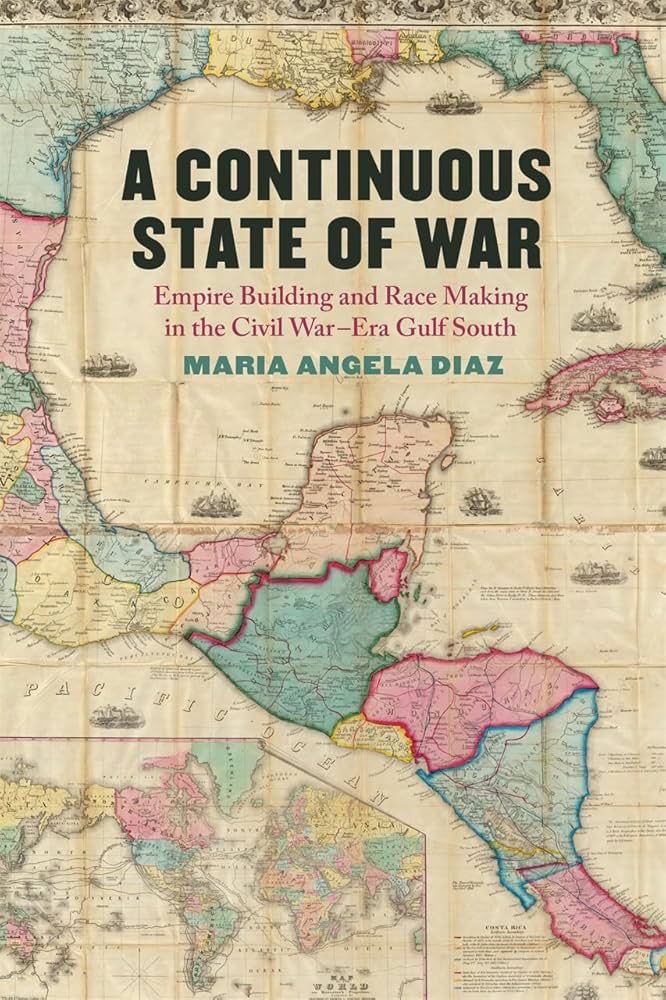Book Review: A Continuous State of War: Empire Building and Race Making in the Civil War-Era Gulf South

 A Continuous State of War: Empire Building and Race Making in the Civil War-Era Gulf South. By Maria Angela Diaz. Atlanta, GA: University of Georgia Press, 2024. Softcover, 230 pp. $29.95.
A Continuous State of War: Empire Building and Race Making in the Civil War-Era Gulf South. By Maria Angela Diaz. Atlanta, GA: University of Georgia Press, 2024. Softcover, 230 pp. $29.95.
Reviewed by Phill Greenwalt
“This is a book about failure. It is about the failure of Southern imperialism and the failure of white Southerners’ attempts to steer American expansion southward into Latin America,” explains Maria Angela Diaz about her recent study titled A Continuous State of War: Empire Building and Race Making in the Civil War-Era Gulf South. (4) The rest of that particular paragraph outlines the various “failures” of empire building efforts and brings into “sharp relief white Southerners’ frustration with the fact that their lived realities often failed to measure up to the fantasies they created.” (4) A Continuous State of War is about territorial expansion and the various layers of history—social, cultural, and military—throughout the mid-19th century.
Diaz, an assistant professor of history at the University of Illinois Urbana-Champaign, contends that in the decades bracketing the American Civil War, “the Gulf South fought with Native Americans, Mexicans, Cubans, the Spanish, and finally . . . each other, white Northerners, and free and enslaved African Americans.” (2-3) In this comprehensive narrative, Diaz sweeps through the Gulf Coast states, from Florida to Texas, chronicling events from the independence movement of the Texas Republic, through the American Civil War, and into the era of Reconstruction, ending with a slight nod to the emergence of the United States as an imperialistic power.
Combining social, geopolitical, ethnic, and cultural themes, Diaz constructs a history that captures the experiences and convictions of the Gulf South during these momentous decades. By including accounts from Latin America and Mexico, Diaz weaves into the narrative the racial tensions, expansionist mindsets, and military ventures that earmarked these decades. Particularly relevant is her coverage of the violence in Texas during their independence movement, the wars in Florida fighting the Seminole Native Americans, and the role of the Civil War in this geographic region.
For example, what happened in Texas was a “foreshadowing of much of Southern expansionist efforts in Latin America territory . . . after Texas was finally annexed into the United States. . . .” This included the Santa Fe Trail, defining the borders with New Mexico and Mexico proper, and the romanticization of Texas soldiers. (26) Insightfully, Diaz’s shows the evolving mindsets and attitudes that link the decades culminating with the fissure of the Civil War in 1861. The author also acknowledges where fellow historians like Megan Kate Nelson have added to the formation of the context and were part of the historiography that evolved into A Continuous State of War. The author reinforces this point further by identifying how this work is a “new sight—the sight of ruin” which the South experienced during the Civil War years. (157)
Although the book admittedly deals with a heavy subject, Diaz presents a thought-provoking, engaging, and complex history. Furthermore, the book challenges readers to take another critical look at this period. The seeds of future American expansion were planted in this region, stirred during the tumultuous four years of war, and then replanted to sprout as American imperialism. As Diaz sums it up in her conclusion, “The use of race to support Anglo American dominance at home and abroad was defined during the earlier territorial expansion of the Civil War era.” (182) A Continuous State of War is an important read and one that helps us better understand the reverberations of history throughout the Gulf of Mexico region.